04/11/2025

During this truffle tour, we discuss, among other things, the different ways of life throughout the ages, how people lived on these poor, limestone lands, and how truffle cultivation has influenced agriculture and lifestyles.
Whether you are a family with or without children, a couple, a group of friends, or a team-building event, I would be delighted to welcome you and share my passion for truffles and this way of life.
I often think that these truffle tour are unique opportunities for encounters, exchange, and sharing.
Truffle warm the body and soul !

I write this article to share with you some records, photos, video, of the tour.
I received Narrekan and his wife un February. An entreprenership couple from Tenesse with a long family hstory. Both, their grand father emigrate in thailand and their parents to US.
They were fascinated by the truffle farmer life and place of livng, We had a fun time with lot of laught and child's mind.

I received company for team building. Lot of surpises, proudness, excitation and treat !




Michael and his family bought a castle in Dordogne. He loves dordogne and truffle. He came 3 times with friends for a christmas truffle tour !


What do they think about the truffle and its perfume :
Sometimes, the photos speak more than the words ... :















It can takes time to dig the truffle ! my friend Nigel is very careful.
This message warms my heart !

Thanks to some of my partner for sharing their truffle experience in Gentillou :
Suzie and Frank : Visiting the truffle farmer
https://luxevakantiehuis-dordogne.com/fr/visite-chez-le-trufficulteur/
Karen and Peter :
https://fontalbe.com/truffles/
Sue and Vincent :
https://www.dordognevineyardtours.com/truffle-tours/
Maison Louverie :
https://lamaisonlouverie.com/2023/09/13/truffle-hunting-in-the-dordogne-a-guide-for-beginners/
12/09/2023
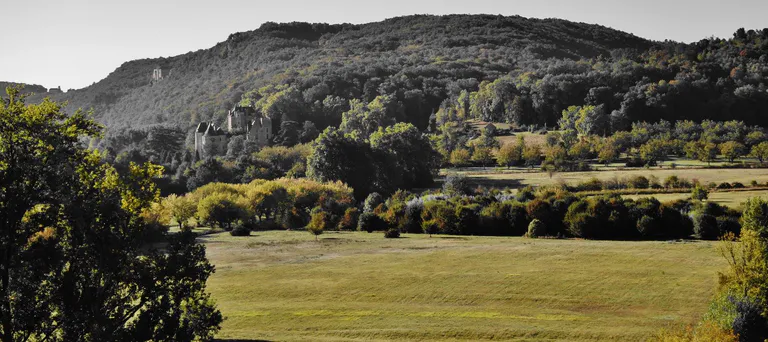

Xavier Mathiaud et Kirsten Pollard
L’agent immobilier Kirsten Pollard travaille dans le secteur de l’immobilier de luxe dans le sud-ouest de la France depuis 17 ans et gère une clientèle tant française qu’internationale. Grâce à sa grande connaissance du secteur et son réseau, nous avons pu aller à la rencontre de Xavier Mathiaud, trufficulteur professionnel depuis 20 ans. Il a d’ailleurs déjà accompagné certains de nos clients dans leur projet de développer une trufficulture sur leur terrain à la suite de leur achat d’un de nos prestigieux châteaux.
Xavier, en tant que professionnel, comment définiriez vous votre métier ?
Être trufficulteur, c’est un métier unique au monde au carrefour de la géologie, la pédologie, la mycologie et l’agroforesterie. On navigue entre la rationalité et la magie.
Comment votre carrière de trufficulteur a-t-elle commencé ?
Tout a commencé en janvier 2003. Mon père et mon oncle étaient du métier depuis déjà plusieurs années, et à cette époque, nous ramassions les truffes à la mouche. Ce qui m’a marqué le jour où j’ai ramassé ma première truffe, c’était le parfum qui s’en dégageait. Celui-ci a fait naître en moi une passion viscérale. Le cavage, c’est comme une chasse au trésor, seulement avec un rapport à la terre très particulier. Cette magie, qui m’a saisie dès le ramassage de ma première truffe, a fait naître en moi le projet d’accompagner les nouveaux propriétaires en Dordogne dans l’identification des zones potentielles pour la trufficulture.
Quelle est l’histoire derrière le succès de la truffe ?
Les premières truffes seraient apparues 12 000 ans avant J.-C., mais la trufficulture comme nous la connaissons, est née en France et en Italie à l’âge d’or au 19ème siècle. À cette époque, on ramassait plus de 1000 tonnes de truffes par an. À l’heure actuelle, on en ramasse seulement entre 60 et 80 tonnes par an. Mais la trufficulture renaît seulement depuis les années 1980. À cause de l’exode rural, la production avait chuté tout le long du 20ème siècle due à une perte de connaisseurs et de connaissances. La truffe, étant un joyau du patrimoine français, des recherches ont été lancées et c’est ainsi qu’on a réussi à décoder le génome de la truffe en plantant des arbres mycorhizés. Comme les expérimentations ont réussi dans les années 1980, c’est dans les années 1990 que beaucoup se sont relancés dans la trufficulture. Mon père, mon oncle et moi-même sommes parmi les premiers à s’être relancés dans la «trufficulture moderne».
Qu’est-ce qui est nécessaire pour se lancer dans la trufficulture ? Quels facteurs auxquels on ne pense pas généralement sont à prendre en compte ?
Tout d’abord, il faut faire appel à un expert qui saura diagnostiquer si le terrain est favorable à la trufficulture ou non. Il faut également compter 2000 m² de terrain minimum pour que ce soit intéressant. Sur un bon terrain où le sol est bien travaillé et l’écosystème favorable, les premières truffes apparaissent au bout de 5 à 10 ans. Quant à la pleine production, il faut compter entre 10 et 15 ans. Je dirai que pour être un bon trufficulteur, il faut compter minimum 20 ans d’expérience.
Au-delà du terrain, il y a des essences favorables au développement de la truffe à prendre en compte. La vigne par exemple en fait partie puisque celle-ci aère les sols. Sur une ancienne vigne, on pourrait garder un rang sur 3 pour planter des chênes truffiers sans que ce ne soit dommageable pour la vigne ou la truffe. On peut travailler sur une truffière paysagère en associant une dynamique paysagiste à la truffière pour une trufficulture esthétique. C’est un travail qui nécessite des compétences de paysagiste associées à des contraintes techniques.
Il faut ensuite choisir les bonnes essences. Ce sont les pépiniéristes qui vendent les plantes nécessaires et un certain nombre de protocoles sont à prendre en compte afin de certifier que les plants sont mychorisés avec le bon champignon.
Après avoir planté, il faut travailler. Il faut aussi savoir que ce n’est pas que la taille de l’arbre qui compte. Il y a la remycorhization, l’entretien des racines et l’aération. Mais même en travaillant un arbre, la truffe peut pousser sur celui d’à côté. C’est là que réside toute la magie de la truffe. Un arbre et un champignon ne peuvent pas vivre l’un sans l’autre, c’est une symbiose.
En termes de qualité, pour être un bon trufficulteur, je dirai qu’il faut être humble, observateur et patient. La truffe est capricieuse. Il faut savoir que chaque année est différente de la précédente. La trufficulture se passe sous le sol, on ne peut donc que supposer. Dans ma truffière, il y a une zone complètement brûlée où rien ne pousse depuis 27 ans ! Et pourtant, il y a quelques jours, mon chien y a repéré une truffe… C’est la toute première fois que j’en ramassais une à cet endroit. Il faut donc s’attendre à tout, c’est une aventure pleine de surprises !
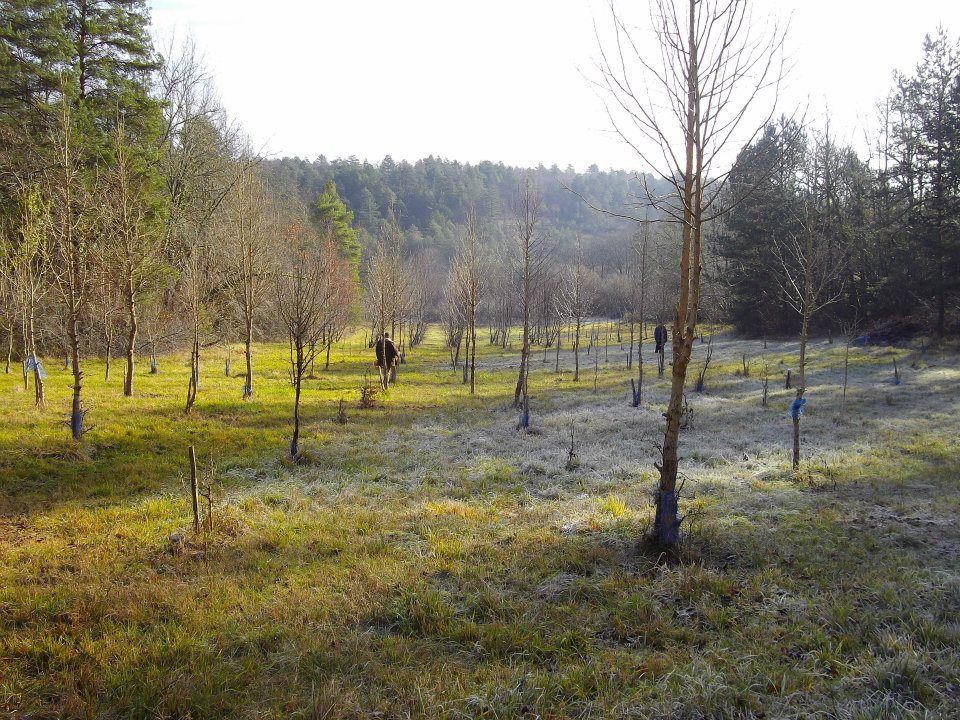
Pourquoi le sud-ouest de la France est un secteur si prometteur pour la truffe ?
Historiquement, au 19ème siècle, la truffe se développait en Dordogne, dans le Lot, la Touraine et en Provence. François 1er d’ailleurs consommait les truffes de Touraine. À l’heure d’aujourd’hui, les truffes se développent dans d’autres régions dues au changement climatique. La truffe a besoin d’air, de lumière et de calcaire. Elle pousse dans des terrains pauvres. C’est le cas de la Dordogne dont les terrains sont très favorables à notre célèbre or noir.
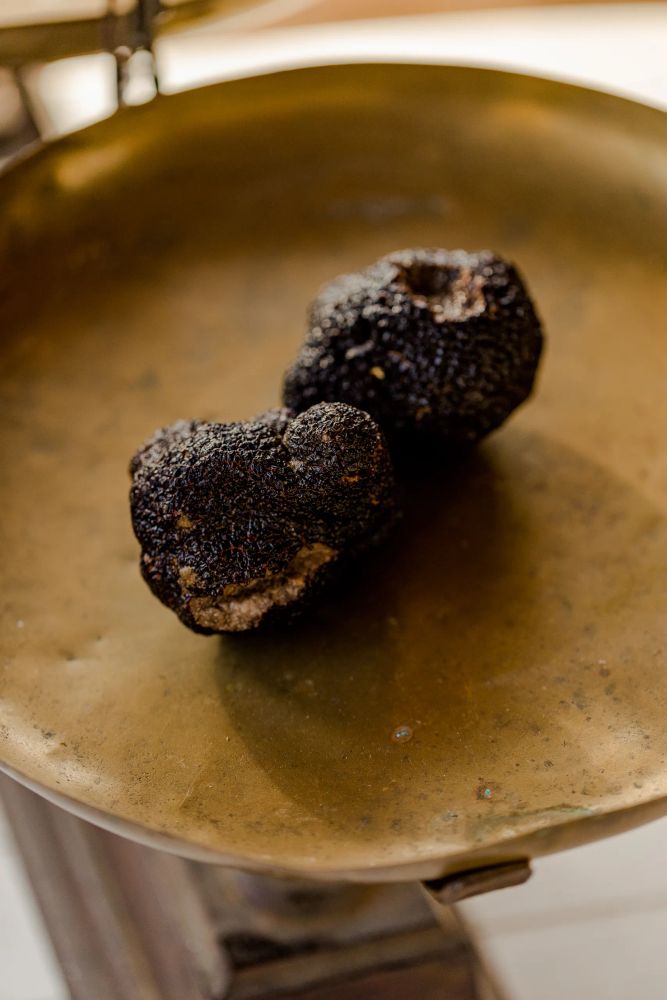
Est-il vrai que la truffe du Périgord est considérée comme la meilleure au monde ? Si oui, pourquoi ?
Ce qui fait la célébrité de la truffe du Périgord, aussi appelée la tuber-melanosporum, c’est son parfum, propre à son terroir. En effet, la truffe se consomme comme un parfum imprégnant délicatement notre cuisine. C’est la densité olfactive qui fait sa richesse. D’ailleurs, une des truffes possédant une densité olfactive surprenante est la truffe d’Alba blanche, originaire d’Italie. Aujourd’hui, on a réussi à décoder le génome de cette dernière et il est donc également possible de se lancer dans la trufficulture de la truffe blanche d’Italie.
Quelle est la saison de la truffe ?
La période de la truffe est de décembre à fin février. Il faut compter 9 mois entre la fécondation de la truffe, commençant généralement au mois de mai et la récolte de cette-dernière. Par la suite, celle-ci se développe en taille durant l’été et prend sa maturité et son parfum en hiver. C’est pour cela que le marché aux truffes commence début décembre. Chacune des truffes est qualifiée, c’est-à-dire validée par un professionnel quelques heures avant l’ouverture du marché. Peu de temps après l’ouverture du marché, les truffes sont presque toutes vendues. Je qualifierai le monde de la truffe comme folklore. Tout part à une vitesse incroyable.
Quels critères sont à prendre en compte pour une personne souhaitant investir dans une propriété de la région dans le but de démarrer une trufficulture ?
Déjà, il faut bien entendu posséder un terrain favorable. En général, il y a toujours un terrain favorable sur 20 hectares de terrain dans notre région. Mais il faut faire attention, car beaucoup de terrains sont très acides. Le Périgord noir par exemple compte beaucoup de truffières sauvages. Investir dans une propriété de plusieurs hectares là-bas est souvent un combo gagnant. Certains trufficulteurs sauront repérer en un coup de pelle si le terrain est favorable. Mais des analyses scientifiques sont également nécessaires pour valider la capacité du terrain à être truffier.
Traditionnellement, ce sont les cochons truffiers qui sont utilisés pour la chasse aux truffes. Cependant, à l’heure actuelle, il semblerait que les chiens soient davantage mobilisés.

Xavier Mathiaud et Rigo récoltant une truffe
Pourquoi cela ? Quel est le meilleur allié truffier pour un trufficulteur ?
Au 19ème siècle, il était naturellement plus facile d’aller aux truffes avec un cochon qu’avec un chien. Ce sont les femelles qui étaient utilisées, car celle-ci éprouve une attirance chimique et physique pour la truffe dégageant l’odeur de l’hormone mâle. C’est pour cela que ces derniers sont plus rapide qu’un chien. Mais l’attirance est si puissante qu’ils mangent la truffe et c’est pour cela qu’aujourd’hui plus personne n’a de cochons truffiers. Tous les chiens peuvent sentir la truffe, mais le Lagotto Romagnolo, chien d’Italie, est idéal pour le cavage car, il est très sensible au parfum de la truffe l’appréciant énormément. Pour ma part, j’ai adopté mon premier Lagotto en 2006 avant même son succès. Mon chien Rigo est très performant au cavage, mais a quelques problèmes de concentration. C’est pour cela qu’il faut adapter la technique et la relation avec son chien en fonction de la relation du chien à la truffe. Tout est un jeu d’équilibre entre le relationnel et la formation. Certains chiens sont opérationnels tout de suite et d’autres nécessitent un peu plus de temps.
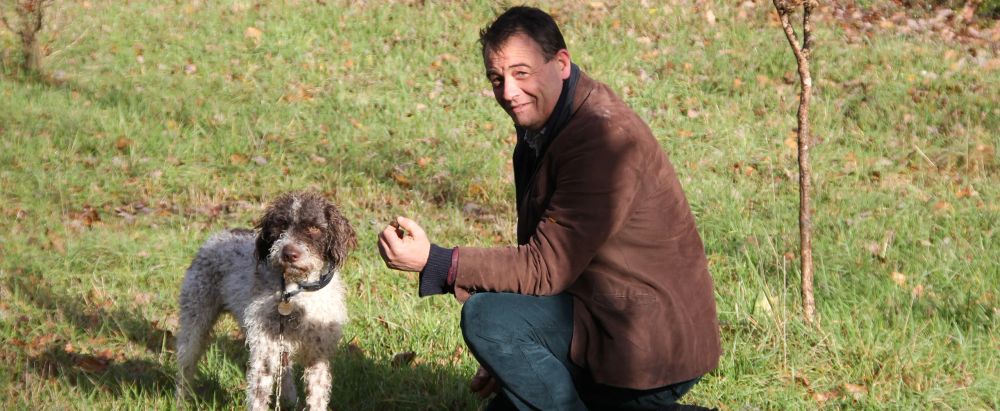 Xavier et son chien Rigo, Lagotto Romagnolo
Xavier et son chien Rigo, Lagotto Romagnolo
Si vous souhaitez vendre ou investir dans la merveilleuse région de Dordogne, notre agent Kirsten Pollard se tient à votre disposition pour vous accompagner dans votre quête de la propriété idéale.
Nous remercions Xavier Mathiaud de nous avoir reçus et d’avoir partagé sa passion, qui ne nous a pas laissé indifférents. En compagnie de nos agents et de Xavier Mathiaud, nous serons ravis de vous accompagner du début à la fin de votre projet, de l’acquisition d’une propriété hors pair au développement et à l’aménagement de votre future truffière.
Article rédigé par Caroline Mudrack
06/09/2022
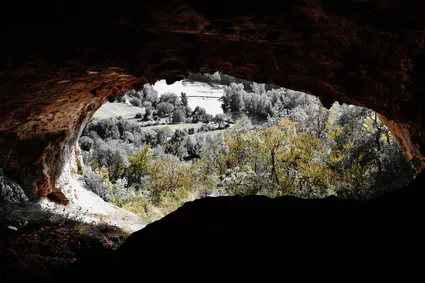

Au moins depuis l'antiquité ! Des tablettes d'argile sumériennes datant de 3700 av. JC mentionnent déjà la truffe. On raconte aussi que dans l'Égypte ancienne, le pharaon Khéops en était friand et faisait préparer des plats à base de truffe pour ses invités venus de l'étranger. Vers 1700 av. J.-C, dans la Bible ensuite, « pommes d'amour » que Léa, épouse de Jacob, se disputait avec Rachel, pourraient correspondre à des truffes. Pour le philosophe grec Théophraste (IVe et IIIe siècles av. J.-C.), les truffes naissaient des pluies d'automne accompagnées de tonnerre. Dans le monde romain, qui appréciait particulièrement les truffes de Libye, Cicéron (106-43 av. J.-C.) les considérait comme des « enfants de la terre ». Plutarque (50 - 125 après J.-C.) affirme que la truffe est générée par la foudre elle-même : « Puisque lors des orages, des flammes sortent de vapeurs humides, quoi d'étonnant que la foudre frappant le sol donne naissance à des truffes, qui ne ressemblent pas à des plantes ». Pline l'Ancien (1er siècle après JC) les considérait comme des « callosités de la terre » tandis que Juvénal était si enthousiaste qu'il « préférait qu'il lui manque le blé plutôt que les truffes ».
Au Moyen Age, la truffe sera ignorée, interdite. Elle reste la nourriture des loups, des renards, des blaireaux, des cochons, des sangliers et des rats. Certains y voyaient l'œuvre du malin puisqu'elle était "aussi noir que l'âme d'un damné"
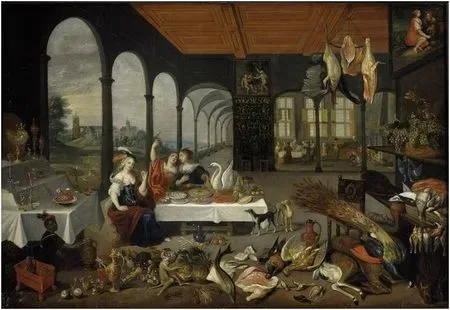
C'est à la Renaissance qui ravive le goût de la bonne chère que la truffe va conquérir la première place parmi les mets les plus raffinés. Au XVIe siècle, le roi François 1er les réintroduit à la cour. On pensait alors qu'elles avaient des vertus aphrodisiaques ! La truffe française sera consommée en grand nombre. Elle sera présente à tous les repas. La truffe noire retrouve ses titres de noblesse. Le diamant noir devient un produit de luxe sous Louis XIV et est commercialisé comme tel à partir du XVIIIe siècle. Elle profite alors de toutes sortes de rumeurs. La « Montespan », la considérant comme un aphrodisiaque, en fit largement consommer par le roi Louis XIV lorsqu'il s'affaiblissait. Madame de Pompadour, favorite de Louis XV, aimait la soupe aux truffes et au céleri, arrosée de tasses de chocolat ambré. Cette façon de préparer les truffes "échauffe les esprits et les passions".
En Italie, au XVIIIe siècle, la truffe piémontaise ("truffe blanche") était considérée comme un mets de choix. La recherche de la truffe était un plaisir. Les invités étrangers et les ambassadeurs en visite à Turin étaient invités à les chasser. D'où peut-être l'habitude d'utiliser pour sa recherche un animal élégant comme le chien, au lieu du cochon, plutôt utilisé en France.
La trufficulture, au sens de "Culture", prend son essor au début du XIXème siècle. Grâce à Joseph Talon, qui vers 1810, près d'Apt dans le Vaucluse, eut la fameuse idée de planter des glands récoltés sous des chênes truffiers producteurs. C'est pour cette raison que Joseph Talon est considéré comme le père de la trufficulture moderne. De nombreux récoltants ont imité cette pratique en plantant plusieurs milliers de truffiers, notamment dans le sud-est. Ce développement a été largement favorisé par la crise que traversait la viticulture française. En effet vers 1880 le vignoble national fut dévasté par le phylloxera alors que les sols calcaires et bien exposés des différents vignobles se prêtent parfaitement à la culture délicate de la truffe noire.
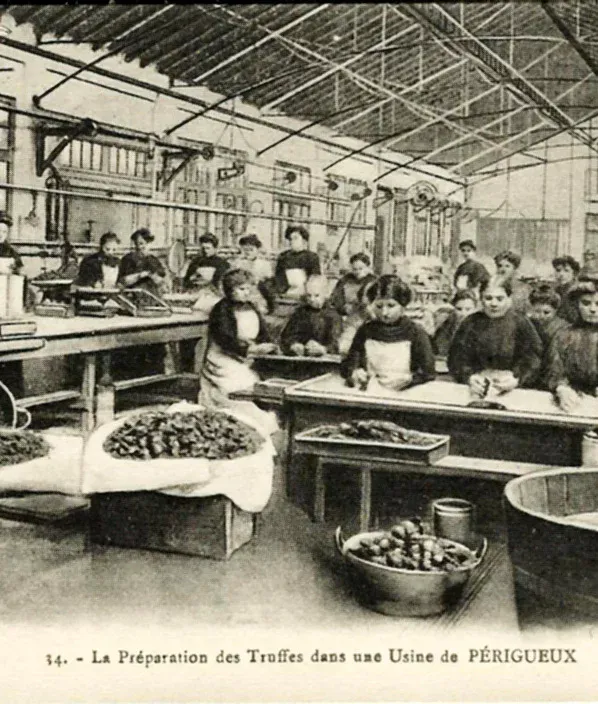
Objet de recherches scientifiques, elle fut analysée par le mycologue italien Carlo Vittadini en 1831 qui lui donna le nom scientifique binomial de Tuber melanosporum.
Dans le même temps, elle atteint sa plus grande renommée et connaît son apogée. Enfin cuisiné pour lui-même et pour sa saveur délicate, elle est de toutes les cartes. En 1873, la récolte française est énorme : elle atteint environ 1600 tonnes annuelles (Basses Alpes, la Drôme, le Quercy, le Périgord et la Touraine). En 1890, 75 000 hectares sont plantés de chênes truffiers. En 1825, le gastronome Brillat-Savarin leur donne le surnom de « diamants de la cuisine » et déclare : « Qui dit truffe prononce un grand mot qui réveille des souvenirs érotiques et gourmands dans le sexe en jupe, et des souvenirs gourmands et érotiques dans le sexe avec une barbe ». Brillat-Savarin aimait la truffe, surtout avec la volaille. Pour Jean Anthelme, la recette et les proportions sont assez simples. Pour faire une volaille truffée, il faut prendre une belle volaille de 2 kilos et 2 kilos de truffes. Simple et terriblement efficace !
A la fin du XIXe siècle, l'histoire économique mondiale est marquée par la révolution industrielle. L'exode rural inhérent à la révolution industrielle a dépeuplé les campagnes. Faute d'entretien et du fait de la rareté des troupeaux de bétail, le milieu forestier s'est progressivement fermé. Les pertes humaines liées à la Première Guerre mondiale ont accentué la désertification rurale et la disparition des savoirs traditionnels.
Dès le traité de Rome de 1956, l'Europe s'est fixé comme objectif l'autosuffisance alimentaire, ce qui a conduit à une révolution agricole. La culture intensive, la mécanisation excessive, l'utilisation intensive d'engrais chimiques et de désherbants ont rompu le fragile équilibre écologique favorable au développement de la truffe.
Ainsi, de la fin du XIXe siècle aux années 1970, on assiste à un épuisement de la production truffière française et mondiale.
La baisse de production depuis le début du 20ème siècle a été si importante que dans les années 1970 la truffe était considérée comme une espèce en voie de disparition.
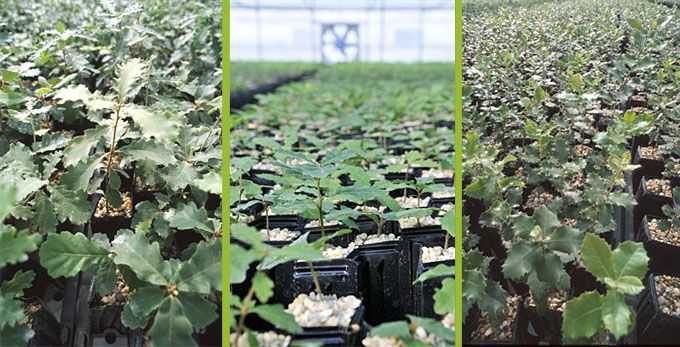
A partir de 1970, le monde français de la truffe s'organise. Personne ne vivait exclusivement de la récolte de la truffe mais le revenu supplémentaire résultant de cette activité suscitait l'intérêt. Cette redécouverte du diamant noir s'accompagne de la mise en place d'importantes recherches scientifiques visant à percer ses secrets.
L'INRA est venu à la rescousse de la filière. Les résultats de cette approche permettent de développer la plante mycorhizée. Après plusieurs perfectionnements techniques, le procédé développé par l'INRA donne de premiers résultats satisfaisants. La technique consiste à apporter l'inoculum sous forme d'une préparation à base de spores de truffes obtenue par broyage mises en contact avec les racines de jeunes plants.
Toutes les plantes vendues sous contrôle INRA ou CITFL sont minutieusement et individuellement contrôlées pour garantir la production de la truffe noire du Périgord. Ainsi chaque plante mycorhizée achetée est exclusivement porteuse de spores de tuber melanosporum.
Ces avancées scientifiques sont soutenues depuis les années 1980 à ce jour par des aides et subventions (départementales, régionales, nationales et européennes).
Ces efforts ont permis la préservation de la truffe noire du Périgord. Bien que nettement inférieures à la production du XIXe siècle, les récoltes annuelles permettent de répondre à une demande toujours croissante.
A ce jour, malgré tous les efforts scientifiques, elle garde ses secrets pour le plus grand plaisir des trufficulteurs et des gourmets !
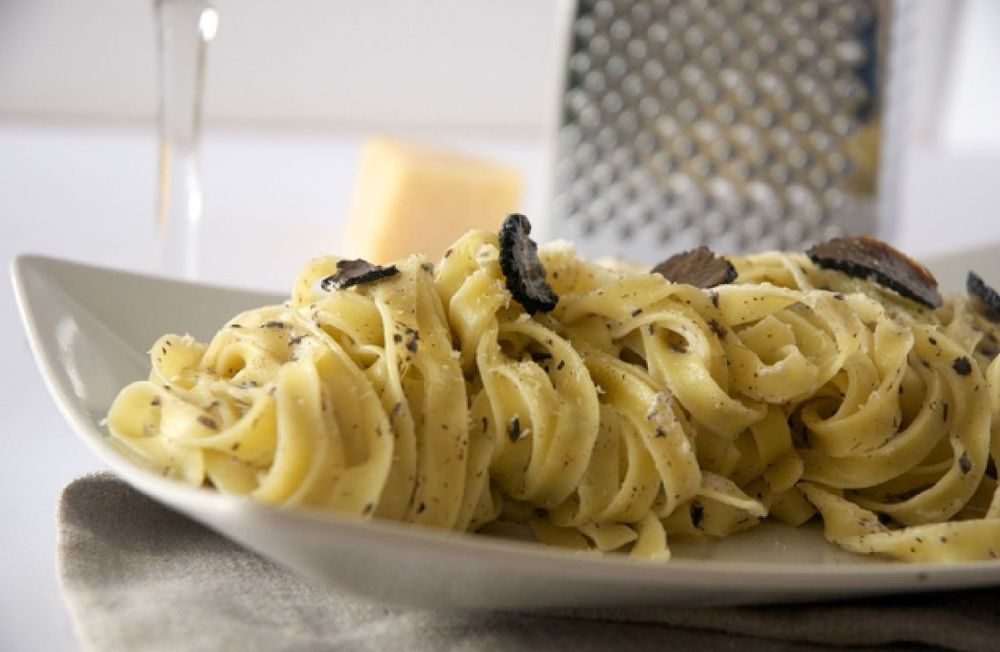
MA TERRE PREMIERE, Gentillou, 24140 Saint Martin des Combes
xaviermathiaud@materrepremiere.fr